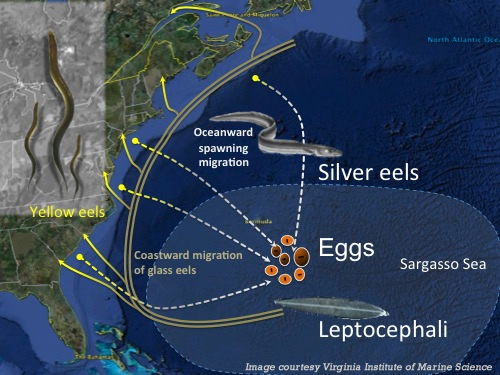Life History
The American Eel is a catadromous species that lives its adult life within inland waters along the Atlantic and Gulf coasts of North America, the St. Lawrence Seaway, and the Great Lakes; and spawns in the open ocean waters of the Sargasso Sea in the northwest Atlantic.
Spawning & Larvae
The species is supported throughout its range by a single spawning population. Spawning takes place during winter to early spring in the Sargasso Sea. Eggs hatch into leaf-shaped, transparent, ribbon-like larvae called leptocephali, which are transported by ocean currents (over 9-12 months) in a generally northwesterly direction and can grow to 85 millimeters in total length.
Glass eels, elvers, and yellow eels
Within a year, metamorphosis into the next life stage, called a glass eel, occurs in the Western Atlantic near the east coast of North America. Coastal currents and active migration transport the "young-of-year" glass eels into Maryland and Virginia estuaries from February to June. As growth continues, the glass eel becomes pigmented (elver stage) and within 12 to 14 months acquires a dark color with an underlying yellow hue (yellow eel stage). Many eels migrate upriver into freshwater rivers, streams, lakes, and ponds, while others remain in estuaries. Most of the eel's life is spent in these habitats as a yellow eel.
 Silver eels
Silver eels
Metamorphosis into the silver eel stage occurs during the seaward migration that takes place from late summer through autumn. Age at maturity varies greatly with location and latitude and in Chesapeake Bay may range from 2 to 18 years, with most eels between 2 and 6 years old. American Eel from Chesapeake Bay mature and migrate at an earlier age than eels from northern areas. On reaching maturity, eels migrate back to the Sargasso Sea to spawn and die.
